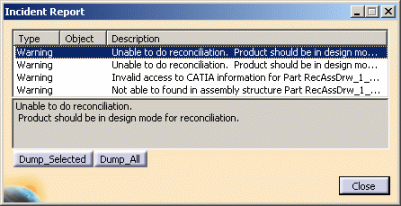
What is the use of the VPDM view?
The VPDM view is used to display the assembly stored in the VPDM. Note
that this view is available only after performing a query on the root
product in the Objects to reconcile tree. |

What is the difference between the Objects to reconcile tree and the
Compare view?
The Objects to reconcile tree shows the objects loaded in the CATIA
session that you want to reconcile whereas the Compare view shows a
simulation of the reconciliation depending on the rules set for each object
to reconcile. |

When reconciling objects, shall I load all documents in the CATIA
session?
Yes. Note that the design mode must be activated. If all documents to be
reconciled are not loaded in the CATIA session, the Supplier Chain Engineering Exchange
application will load them.
|

Is it possible to reconcile all types of documents?
No, only the following document types are supported:
- CATPart
- CATDrawing
- CATProduct
- CATAnalysis
- CATAnalysisComputation
- CATAnalysisResult
- CATIA V4 models
- CATMaterial documents stored in publication exposed mode.
- Catalog documents stored in publication exposed mode.
- CATShape
- Cdma models
|

When mapping data, how can the Supplier Chain Engineering Exchange application
determine that the objects are identical?
You perform a query that checks that the part numbers of the object
loaded in the CATIA session and the ones stored in the VPDM are identical.
You can also use the Characteristics tab to check if the publications
contained in both documents are identical or not. |

Is it possible to use wildcards in queries?
In ENOVIA V5 VPM, you may use the * wildcard. |

Yes. To do so:
- Create a new version in the VPDM.
- Open the document in CATIA and launch the Supplier Chain Engineering Exchange
application.
- Map the object to reconcile with the new version of the object.
- Select the Overwrite reconciliation rule.
 |
Note that the methodology described
above applies to ENOVIAVPM only. For ENOVIA V5 VPM, you can choose to version
the Part when saving the Reconciliation result in ENOVIA. |
|

Is it necessary to set a reconciliation rule for each instance to be
reconciled?
No, the reconciliation applies at the reference level. So if you perform
a query on an instance, it will propagate to the identical instances and
any rule set on one instance will propagate to others also. |

What is the use of the Apply button?
The Apply button, when pressed, enables you to take the reconciliation
rules into account and to apply to the products and the documents the
necessary information to prepare the save operation in the PDM System. Note
that after clicking Apply, these documents lose their "File based" origins
and thus can no more be manipulated as file documents.
|

What is the difference between the Instance view and the Part&Documents
view?
These views are 2 different product representations.
- The Instance view provides you with a representation of the assembly
using its instances (like in CATIA).
- The Part&Documents view shows the documents and the references
contained in the assembly (like in ENOVIAVPM ).
|

Is data saved in the VPDM when I click the Apply button?
No. The Apply button "prepares" the CATIA session for your
reconciliation choice to be taken into account when saving the session to
the PDM.
For example, if you chose the Reload from VPDM option for a
CATPart, the CATPart file loaded in the CATIA session will be replaced by
the one stored in the VPDM when clicking the Apply button. |
 I
cannot display the VPDM View in the 3D Viewer. What can I do? I
cannot display the VPDM View in the 3D Viewer. What can I do?
Make sure that the Work with the cache system option is on
(by default, the cache is not activated).
Otherwise, select the Tools -> Options command, click
Infrastructure -> Product Structure to the left of the dialog box and
check the option.
Do not forget to restart your session after turning on the cache.
Activating this option sets the visualization mode as the work mode. |
 When
should I use the Launch reconciliation from File->Desk and when
should I use the Launch reconciliation from available workbenches? When
should I use the Launch reconciliation from File->Desk and when
should I use the Launch reconciliation from available workbenches?
It depends on what you want to reconcile. If you want to reconcile a
whole product structure, use the Launch Reconciliation icon
 from the
workbench. If you want to choose the document (sub-assembly, part...), use
the File->Desk command. from the
workbench. If you want to choose the document (sub-assembly, part...), use
the File->Desk command. |
 Can
I work in Visualization mode? Can
I work in Visualization mode?
No, you can't. The Supplier Chain Engineering Exchange application is compatible with
the Design mode only. If you work in Visualization mode, the following
error message is displayed:
|
 Is
it possible to reconcile a sub-assembly using the Reconciliation
application and VPM Navigator? Is
it possible to reconcile a sub-assembly using the Reconciliation
application and VPM Navigator?
No, you cannot because you always need to reconcile the top part with a
product root in ENOVIA V5 VPM. One way could be to create a dedicated product for the
exchange in which you instantiated the sub-assembly stand alone. |
 Is
it possible to use the Supplier Chain Engineering Exchange application with a
configured product? Is
it possible to use the Supplier Chain Engineering Exchange application with a
configured product?
No, it is not supported. |
